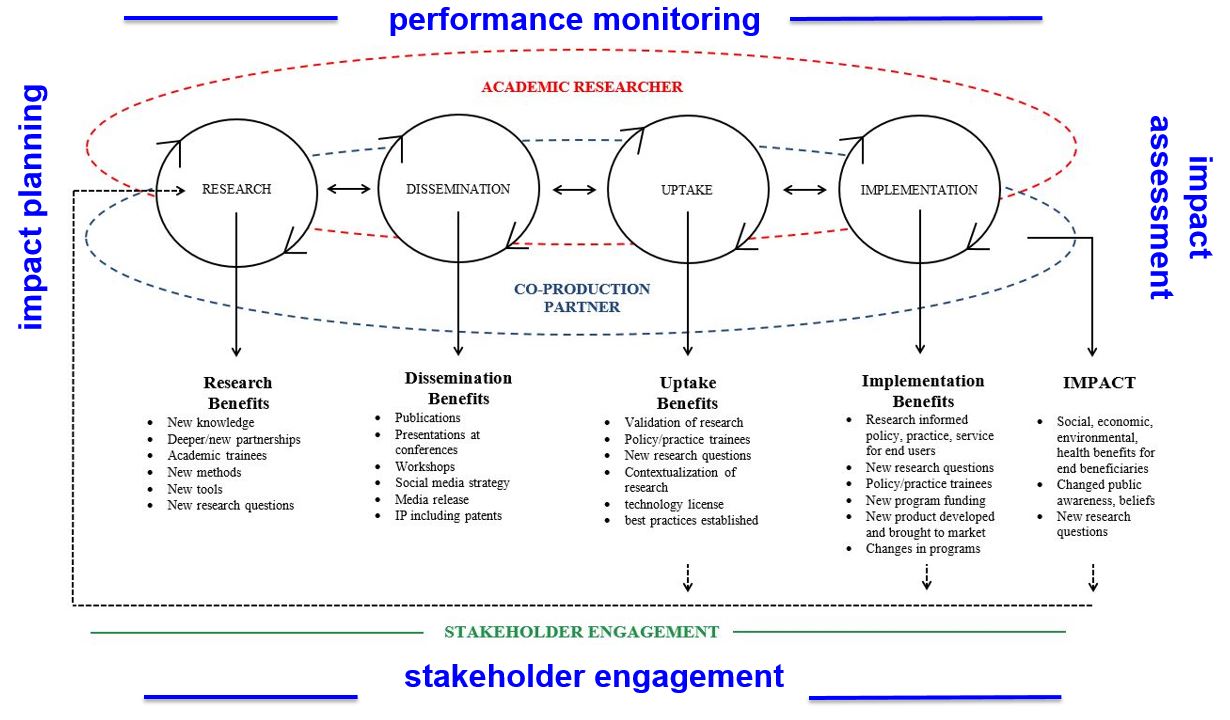In 2016, we published the co-produced pathway to impact (CPPI) with PREVNet to describe the processes that supported research to impact. Working with Kids Brain Health Network, KMb York has made some small and not so small additions to the pathway.
En 2016, l’Unité de mobilisation des connaissances (MdC) de York publiait en collaboration avec PREVNet la trajectoire d’impact codéterminée, document décrivant les processus de soutien à la recherche qui permettent à celle-ci d’avoir les répercussions souhaitées – de produire un impact. En collaborant cette fois-ci avec le réseau Kids Brain Health, nous avons précisé la trajectoire grâce à quelques petits ajouts – et à d’autres, moins petits.
This figure illustrates the revised CPPI with changes made based on our +3 years’ experience planning and assessing impact using the CPPI as a framework. The changes described below are not just cosmetic in nature. They provide operational enhancements to the original PREVNet CPPI. Significant changes include explicitly identifying the feedback arrow as stakeholder engagement and changing the “policy/practice partner” to a “co-production partner”. Minor, but still important, changes include differentiating between end users (implementation) and end beneficiaries (impact) and aligning the description of dissemination benefits to be outputs as opposed to processes.

Stakeholder engagement: Listening to stakeholders is crucial because it increases the probability that research outputs will be used, which maximizes the potential for achieving impact(s). The benefits of stakeholder engagement include improved quality and applicability of the research, increased dissemination and uptake of results and empowerment of stakeholders. As covered in the KMb Journal Club, Sam Baars identified that building trust by engaging with stakeholders throughout the research process enhanced the quality of his research because of better data collection.
The dotted arrow returning from impact to research in the original CPPI implies stakeholder engagement informs future projects but making it explicit requires users of CPPI to actively consult with stakeholders. This revised CPPI ‘Stakeholders’ are defined as everyone directly and/or indirectly affected by the research to impact processes, including academic and non-academic organizations/individuals. Some stakeholders collaborate at one or more of the CPPI stages and are thus co-production partners. Some stakeholders do not collaborate but are receptors of research outputs, those audiences that take up the disseminated research evidence. All co-production partners are stakeholders and usually are also end users as they take up the disseminated research evidence. End users are stakeholders but are not (necessarily) co-production partners. When undertaking stakeholder engagement to inform research priorities it is important to listen to all types of stakeholders. It is also important to note that one stakeholder may serve several roles within one project (e.g. research participant, end-user, co-production partner).
“Stakeholders” as co-production partner(s): Most of the non-academic partners for PREVNet are policy and practice/community partners. The application of the CPPI in PREVNet’s context informed the decision to name this group of stakeholders “policy & practice partners” in the original CPPI. The use of the CPPI in the context of KMb York and KBHN co-production partners can include industry and people with lived experiences who are engaged as family/patient co-researchers. Expanding beyond policy and practice partners and identifying them as co-production partners broadens the scope of CPPI partners and helps to address attribution.
“Stakeholders” as end user(s)/end beneficiar(ies): This revised version of the CPPI differentiates between stakeholders as end users and end beneficiaries of the research. End users are those individuals/organizations who actually use (or “implement”) the research evidence into products, policies, practices and services. End beneficiaries are stakeholders upon whom the improved or new products, policies, practices and/or services have an affect. For example, a teacher in the classroom that uses a new educational practice informed by education research is the ‘end user’ while the students who have better education achievement because of the educational practice are the ‘end beneficiaries’. This distinction is important when describing impacts from research. Most of the “impacts” described by Greenhalgh and Fahy are implementation (of research into guidelines, policy, practice) not the impacts those guidelines, policies and public health practices have for end beneficiaries. If research informs a new educational practice (in the CPPI, the “implementation” phase) but that practice fails to enhance educational achievement for students, there has not been any positive impact for end beneficiaries.
These changes are not revolutionary but they are evolutionary. As we (and others including PREVNet, KBHN and other Networks of Centres of Excellence) continue to work with the CPPI we anticipate it will continue to be refined as our understanding of the diverse processes supporting research to impact also become more sophisticated.